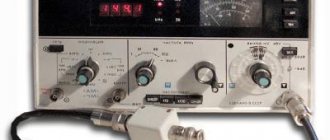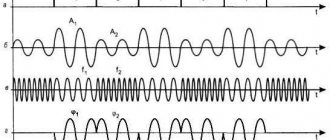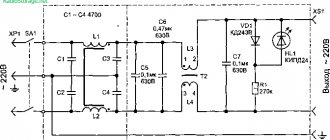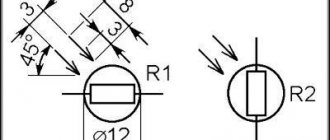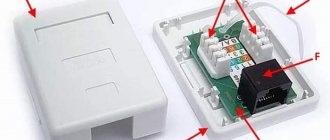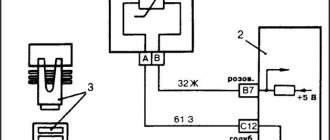In addition to showing the individual wires, it is also important to show additional details of the electrical circuit on the drawing.
ESKD is a Unified System of Design Documentation.
In particular, it is necessary to connect to the local network of a house with an AVR: Photo - a house with an AVR To develop for free a single-line power supply diagram for a child care facility, private buildings, garages, houses, apartments, kiosks, a multi-storey residential building, a SNT plant, crew cars, you will need an ESKD . Single line diagram designer. Description of work.
Single-line diagrams also display markings and types of electrical equipment, their parameters and class=”aligncenter” width=”1024″ height=”723″[/img] An example of designing a single-line power supply diagram for an industrial enterprise Types of single-line electrical diagrams Depending on what stage To complete the work to create the electrical network of the facility, a single-line diagram is drawn up, its type and intended purpose depend.
If the same elements or devices are not located in all circuits shown single-line, then to the right of the reference designation or below it in square brackets indicate the designations of the circuits in which these elements or devices are located, see. Based on these data, the overall picture is visible and the amount of work can be assessed . If the line is single-phase, no additional markings are required.
It is performed after calculating electrical loads, selecting protective switching devices and cable products. Single-line diagram of the enterprise's power supply. Part 2.
Why single line?
Single-line and multi-line from GOST
In relation to electrical circuits, the term “single-line” means that the channels for transmitting electricity and signals are depicted as one line, regardless of the actual number of phases.
Let us immediately emphasize that this principle of simplification is used not only for drawing power lines, but also for schematizing multi-wire control harnesses and buses, the number of wires in which can be more than 3.
This approach can significantly increase the information content of the drawing, so today single-line diagrams are the main document around which the rest of the design documentation is grouped.
The general provisions on the basis of which a drawing of a single-line diagram of electrical equipment is developed are specified in GOST 2.702-2011.
According to this document, the basic principle of simplification can be formulated as follows: 2-3-phase electrical wiring channels are represented by one line, and the number of phases corresponds to the number of oblique “notches”.
Individual elements in a phase
In cases where the number of wires in a line is more than three, a number is used instead of notches. If the line is single-phase, no additional markings are required.
It should be noted that the development of a single-line power supply diagram is carried out, first of all, for a comprehensive analysis of the designed power network, therefore, in most cases, such diagrams are made on one sheet.
When developing circuits for large networks, the principle of multi-level detail is applied. That is, the general (complex) diagram reflects the interaction between large structural blocks, and the details of the structural blocks are given on other sheets.
Devices and switching elements connected to each phase of a multi-wire line are represented by one symbol indicating the phases on which this device is installed.
Procedure for developing OSE
When creating a single-line electrical network project, you will need to comply with certain regulatory rules. In this case, the selection of individual circuit elements must be carried out in accordance with the PUE.
What information should the OSE carry?
The diagram intended to formulate a power supply project will definitely need to reflect:
- connection point to the power source;
- type of input device (automatic machine or distribution point) indicating the rated current;
- information about the meters used to account for electricity;
- brand, length, cross-section and number of current-carrying cores of cable lines;
- calculated voltage losses and load;
- the protective devices used;
- location of internal and external lighting networks.
Development stages
Before starting to develop a single-line electrical network project, you will need to obtain technical specifications. To do this, you will need to contact the municipal electrical network department. The technical condition determines the location of the facility’s connection to the power supply network, as well as the distribution boundaries of the future power supply project.
After this, you will need to visit the department of architecture and urban planning at your place of residence. In it, make a request for the issuance of a master plan for the land plot. This is necessary to accurately determine the location of the supply line from the connection point, excluding intersections with other engineering structures. You can also determine the length of the future cable line.
Procedure for connecting to electrical networks
At the next stage, the planned loads are calculated, with all the required elements displayed on a single-line diagram. At the final stage, all that remains is to approve the project and obtain permission to connect to the power supply network.
GOST requirements and design nuances
The construction of OSE is carried out in accordance with the requirements of GOST ESKD. For this, the following GOST numbers are used:
- 709-89 - current-carrying conductors, electrical equipment and contact connections;
- 710-81 — application of alphanumeric designations;
- 721-74 - elements of general use;
- 732-68 - designation of light sources;
- 755-87 - switching devices and contact connections;
- 702-2011 - rules for designing diagrams.
Alphanumeric designations in diagrams according to GOST 2.710-81
When preparing a drawing, it is recommended to adhere to the following rules:
- Initially, a frame and a stamp of the established shape are drawn.
- If necessary, you can spread the drawing onto several sheets to make it easier to read. In this case, a list with continuous numbering is formed.
- The marking of circuit elements is carried out from the power source to the end consumer. For this purpose, capital Latin letters and Arabic numerals are used. The former indicate the phase of the alternating current, and the latter indicate the sequence of the circuit.
- Odd numbers are used to indicate positive polarity, and even numbers are used for negative polarity.
- Decoding the markings of the circuit components is performed on the left side of the drawing or directly above each element.
- The main parameters of the supply network, as well as consumers, can be included in a separate table. However, its size is not regulated.
- It is allowed to use free sections of the OSE to display the technical characteristics of cable lines in the form of text.
Symbolic graphic display of circuit components
To compile the OSE you will need to use certain conventions. Most of them are reflected by GOST ESKD 2.721-74, 2.709-89, 2.755-87 and 2.732-68 in separate tables.
Project verification and approval
After the development of the OSE is completed, the signature of the direct executor is placed on it. In the future, you will need to obtain approval of the project from a responsible specialist on the part of the supplier, who will verify the provided data.
The final stage will be obtaining permission to implement the project from the head of municipal electrical networks. Depending on the established staff of the specified organization, the checking and approving specialist may combine responsibilities.
Main types of single-line electrical circuits
The development of a single-line diagram is carried out in two cases:
- at the beginning of design (“design diagram”);
- at the operational stage, before upgrading the equipment (“executive single-line diagram”).
An example of an executive single-line diagram.
The design schematic diagram is the main one and is used as the basis for calculating all technical parameters of the electrical network. For initial approvals, this particular version of the scheme is used.
In practice, the original version of the electrical project is often changed at the stage of electrical installation work or at a later date, before modifications and modernization. To plan and record changes, an executive power supply diagram is drawn up.
Let us remind you that according to the requirements of the PUE, after any change in the power supply network or the design of the electrical installation, the electrical project must be re-approved. In this case, the executive version of a single-line diagram is used as the main technical document.
Types of single-line electrical diagrams
There are two main classes of circuits designed at different stages of the project. To create an OSE, you need to know the key characteristics of each type.
Calculation scheme
Single-line design diagram of the ShchR-41 switchboard (office power supply)
Designed at the stage of developing documents for the project being implemented. Here the system characteristics and required loads are calculated. Payment documents may include :
- schematic representation of the structure;
- function diagram;
- wiring diagram;
- drawing documents;
- fire safety diagram.
The electrical equipment structure diagram shows power elements (tie-in points, transmission lines, transformer components and others) and communications between them. A function diagram is created to demonstrate the operation of mechanisms interacting with the electrical network and their impact on the safety of the facility.
It is usually used for industrial premises dealing with an abundance of heterogeneous equipment. The installation project requires coordination with architectural design solutions and strict indication of wire diameters and equipment dimensions.
Valera
The voice of the construction guru
Ask a Question
The draft design scheme is subject to agreement with city or district authorities in order to issue technical conditions for connecting the premises to existing communication networks. The issuance of specifications is regulated by regulatory documents.
Executive scheme
Executive power supply diagram
Created when the premises have already been in use for some time. It is required to graphically display the modifications that are planned to be made to the network structure. The document is prepared when replacing or modifying existing technical equipment. The executive diagram provides information:
- about the current state of the power grid;
- about electrical appliances included in its composition;
- advice on troubleshooting problems discovered during technical inspections and other activities.
If you need to make a diagram of an enterprise, apartment building or other facility with several levels of supply, it is done for each level : for example, for the entire plant, a workshop division and its individual section. First, an image of the PTS and the networks connecting them is made, then drawings are made for a separate PTS or electrical distribution panel, and finally - all the individual panels presented in the room.
What should be shown on a single-line electrical diagram?
Any design option for a single-line diagram of an electrical project must contain the following information:
- boundaries of the areas of responsibility of the energy supply organization and the electricity consumer;
- input distribution devices. If the project uses autonomous generators and automatic transfer switches, they should also be reflected in the diagram;
- electricity meters, with comments on the method of their installation;
- information about all involved distribution cabinets;
- cable line lengths accurate to the nearest meter;
- position and technical parameters of automatic shutdown devices;
- position and technical parameters of the RCD;
- data on all installations consuming electricity indicating power, cos ϕ.
House with ATS
If possible, the mechanical relationship of the elements displayed on the diagram is indicated.
Please note that the symbol of a device or switching device must be accompanied by an additional description revealing its main technical parameters.
There are two ways to post additional information:
- directly next to the element symbol;
- decoding in the specification table.
When using the second method, each element of the circuit must have a unique marker (or number).
The general design of the drawing must comply with the requirements of the ESKD.
Regulations
When developing single-line diagrams, it is necessary to take into account that the symbols used must comply with the following regulatory documents:
- wires, contacts, circuit structuring (GOST 2.709-89);
- switching elements (GOST 2.755-87);
- conventional graphic symbols for elements of electrical circuits (sockets, lamps, RCDs, etc. - GOST 2.721-74).
Separately, it is worth noting that the letter designations for elements of single-line electrical circuits are also standardized and defined in GOST 2.710-81.
Despite a fairly extensive set of standardizing documentation, disagreements sometimes arise regarding some types of UGO. One of the reasons for such inconsistencies is the lack of certain symbols in programs for developing electrical circuits.
For an ordinary developer of an electrical project, this fact may cause a refusal at the approval stage, which is why it is recommended to entrust the development of electrical documentation to licensed organizations familiar with the features of technical control during approval by Energosbyt and Rostekhnadzor.
What is a single-line power supply diagram and why is it needed?
Without a single-line diagram it is impossible to carry out electrical installation work.
A single-line electrical diagram is a document representing the elements of the electrical network of a power supply facility. It also indicates the technical characteristics of each element and the system power indicators (calculated and installed). The purpose of creating a linear diagram is to demonstrate the visual configuration of its components and the connections between them.
The characteristic “single-line” when applied to power supply diagrams means the depiction of communication channels that transmit energy as one line, regardless of whether they are single- or three-phase. This graphical representation allows you to identify power lines and simplify the depiction of busbars and control harnesses equipped with multiple wires. This makes this type of diagram both concise and informative.
A schematic diagram is a drawing that conveys complete information about the electrical, magnetic and electromagnetic connections of system elements and the parameters of the components.
Single-line
Fundamental
Some features of generalized electrical circuits
An example of a primitive single-line diagram
As mentioned above, drawing up a single-line power supply diagram is the main stage in developing an electrical project for a house. In addition to the technical data of the elements, such diagrams also indicate the following type of information:
- additional operating modes (for example, about the emergency operation mode of the ATS);
- calculation of losses in power transmission circuits;
- division of the network by type (backbone, group, distribution).
A single-line diagram developed taking into account the above requirements can later be supplemented with other drawings that do not require separate approval.
Design principles
Principles of construction
When developing and preparing the drawings included in the OSE, it is necessary to strictly comply with the norms of the PUE (electrical installation rules), as well as the requirements for this type of work indicated in the regulatory documentation. Before starting the process, you need to familiarize yourself with the nomenclature of circuit elements .
What should a single-line power supply diagram include?
The content of the single-line diagram is regulated by regulatory documentation presented to the applicant after consideration of the request for obtaining technical specifications. The design diagrams should indicate :
- the framework of the areas of responsibility of the supplier and consumer of electricity - they are presented in the text of the contract for the provision of services for the supply of premises;
- the main distribution board and consumer-owned transformer stations, indicating automatic transfer switching devices (if any);
- autonomous power supply (if available);
- the distribution cabinets of both lighting equipment and power lines present in the room
- horizontal dimensions of main power lines cables used for communication and how they are laid;
- calculated data on energy losses during transmission ;
- information about emergency operation;
- equipment for electricity metering with the designation of the transformation ratio (if a secondary electric current of 5 A is used);
- technical characteristics of fuses, automatic shutdown devices ;
- information about the loads with notes about their power in kW and current.
A drawing developed taking into account the given data can later be supplemented with additional graphical representations that are not subject to special approval.
Question to the expert
Who approves the project?
Signatures, according to regulatory sources, should be collected from the specialist who developed the scheme, the official who checked it, and the manager who approved the project. The initial approval is approved by the person responsible for the power supply on the consumer’s side, and subsequent approvals are determined by the characteristics of the premises and the work carried out in it.
Design stages
The stages of developing a single-line diagram have a certain sequence. First, the applicant is required to submit a request to the company providing electricity supply services to issue technical specifications for the implementation of this task. After waiting for the documents regulating the process to be received, consumer representatives prepare a draft scheme for these specifications. The developed drawing is agreed upon with the company that issued the technical specifications.
If during the operation of the electrical network there is a need to make changes to the configuration of its elements , an executive diagram . The sequence of stages for it will be identical.
Design rules, GOST requirements
When preparing drawings for the project under review, it is necessary to strictly follow the GOST standards of the Unified System of Design Documentation, which regulate the specifics of the development of such electrical circuits.
Numbers of state standards:
- 2.721-74 – introduces graphic symbols in diagrams;
- 2.755-87 - describes how to designate switching devices and contact connections;
- 2.709-89 – talks about wire symbols;
- 2.710-81 – signs combining letters and numbers.
Conventions used in drawing up single-line diagrams
The visual representation of the various elements that make up the energy supply system is regulated by regulatory sources. Boxes, panels and cabinets have their own designations in the drawing documents:
- Shields are shown as rectangles. The main shield elements have a horizontal line that cuts off a small fragment at the bottom. Group elements responsible for working lighting are filled with black paint; for emergency lighting, they have two diagonals.
- Single panels and one-way service cabinets are represented by squares with a fragment cut off horizontally at the bottom. Double-sided service elements have cut-offs at the top and bottom. This rule also applies to elements from several panels, only they are presented as the corresponding number of squares arranged in a row.
- The pull-out box has a square shape. The introductory box is represented as a square crossed out by a thick vertical line.
- The branch box is depicted as a circle with a thick transverse line and a vertical line going down from the center of the circle.
A regular switch looks like a circle with a line extending from it to the right and upward. The number of poles (one, two, three) is demonstrated by the number of small vertical lines at its end. If an open installation is assumed, the lines are drawn from the base to the right and down, and in the case of a hidden one , it is intersected by transverse lines. Double and triple elements have two or three lines instead of one. A high degree of protection is demonstrated by painting the circle black. If the element works in two directions , a second line is drawn to the left and down from the circle.
The socket is shown as a “lying” semicircle with a line extending upward from the top. The presence of two poles is described by a second similar feature, the protective contact is an additional horizontal, hidden installation - running from the center to the top. Strong defense is shown by shading in black.
Designation of lighting fixtures
Designations of lighting devices :
- Lamps with fluorescent lamps are shown as elongated rectangles, other devices are shown as circles.
- The cable is depicted with a transverse dotted line and a thick line under it near the “equator” of the circle.
- External lighting devices are shown with the letter “T” turned on its side, growing from the left side of the circle.
- The chandelier is shown by dividing the circle into 6 segments.
- The lamp wall socket is a blackened triangle with a V-shaped fork on top.
- The suspended cartridge is a circle crossed out by diagonals. Ceiling - similar, but the crossing out elements located within the figure are not applied to the image.
- Ammeter, voltmeter, galvanometer are round shapes with the letters A, V and an upward arrow inside, respectively.
- Temperature sensor and oscilloscope – squares. The first has a t inside and an arrow pointing to the right that coincides with the base. The second one has a thin N-shaped image of a lightning bolt.
- The electricity meter is a tall rectangle with a separated upper segment and the inscription Wh.
If the circuit designer has any doubts about how to depict a particular element, he can familiarize himself with the nomenclature of OSE symbols in the reference literature.
Who checks and approves
According to regulations, a single-line diagram of an electrical project must be signed by the following employees:
- developer;
- inspector;
- approving manager.
The further procedure for approvals depends on the specifics of the project, but the first approval is endorsed by the person responsible for electrical equipment on the consumer’s side.
The Mega.ru campaign is a licensed developer of electrical documentation and provides professional development of single-line diagrams for buildings and structures that are subject to approval by Moenergosbyt. To clarify the terms of cooperation, please call the numbers published in the “Contacts” section.
